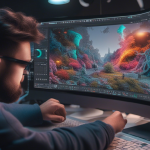Revolutionizing Digital Storytelling with Motion Graphics and 3D Design

Introduction
Traditional methods of storytelling have long relied on static images and words to captivate audiences. However, these methods have their limitations when it comes to creating immersive and engaging narratives in the digital age. Enter motion graphics and 3D design – two innovative tools that are revolutionizing the way stories are told.
In today’s fast-paced and visually-driven world, it’s essential to explore new avenues for storytelling to captivate audiences. Motion graphics and 3D design offer unique opportunities to create dynamic and interactive narratives that leave a lasting impact on viewers. By utilizing these techniques, storytellers can enhance their digital storytelling to the next level.
Understanding Motion Graphics
Motion graphics refers to the art of animating graphic elements to tell a story. It encompasses various techniques such as animation, typography, and visual effects to create captivating visuals. From film and television to marketing and advertising, motion graphics find applications across a wide range of industries.
Evolution of Motion Graphics in Storytelling
Over the years, motion graphics have evolved from simple animated text to intricate animations and visual effects. This evolution has been driven by advancements in technology, allowing for more sophisticated and realistic animations. Today, motion graphics seamlessly integrate with other storytelling elements, creating a seamless and immersive viewer experience.
Impact of Motion Graphics on Audience Engagement
Motion graphics have a powerful impact on audience engagement, grabbing attention and conveying complex information in an easily digestible format. Through motion graphics, storytellers can communicate emotions, concepts, and narratives in a visually compelling manner. The dynamic nature of motion graphics keeps viewers engaged and enhances their overall storytelling experience.
The Power of 3D Design
3D design has emerged as a game-changer in digital storytelling, offering a new dimension of visual storytelling. With its ability to create lifelike environments and characters, 3D design adds depth and realism to narratives, allowing audiences to immerse themselves in the story.
Advantages of Using 3D Design in Digital Narratives
The advantages of employing 3D design in digital narratives are abundant. It enables storytellers to create visually stunning and immersive worlds, making narratives more captivating and memorable. Additionally, 3D design allows for the manipulation of perspectives, giving storytellers greater control over the visual storytelling experience.
Successful 3D Design Implementation in Storytelling
Various industry examples highlight the successful implementation of 3D design in storytelling. For instance, in animated films, 3D design has revolutionized the creation of characters and environments, enabling filmmakers to bring their visions to life. The gaming industry also heavily employs 3D design to create visually stunning and interactive narratives that captivate players.
Combining Motion Graphics and 3D Design
The synergy between motion graphics and 3D design is a winning formula for revolutionizing digital storytelling. By combining these techniques, storytellers can enhance their narratives and create visually compelling experiences for their audiences.
Enhancing Storytelling through the Fusion of Techniques
The combination of motion graphics and 3D design offers a unique opportunity to create narratives that seamlessly blend visually stunning animations with lifelike environments. By using motion graphics to animate elements within 3D environments, storytellers can create a truly immersive and captivating experience for viewers.
Tools and Software for Motion Graphics and 3D Design
To bring motion graphics and 3D design to life, storytellers rely on a variety of software and tools specifically designed for these purposes.
Popular Software and Tools in Motion Graphic Design:
Adobe After Effects: This industry-standard software allows for the creation of motion graphics, visual effects, and compositing.
Cinema 4D: Widely used for 3D animation, this software offers powerful capabilities for creating lifelike environments and characters.
Autodesk Maya: Known for its versatility, Maya is extensively used in industries such as film, television, and gaming to create stunning 3D visuals.
Key Features and Capabilities of These Tools
Each software mentioned above possesses unique features and capabilities that cater to different aspects of motion graphics and 3D design. Adobe After Effects excels in creating animated elements and applying visual effects, while Cinema 4D offers advanced 3D modeling and rendering capabilities. Autodesk Maya, on the other hand, provides a comprehensive suite of tools for character rigging, animation, and simulation.
Choosing the Right Software for Your Project
When selecting software for motion graphics or 3D design, consider factors such as your specific needs, budget, and level of expertise. It’s essential to choose software that aligns with your project requirements and provides the necessary tools and functionalities to bring your storytelling vision to life.
Techniques for Creating Engaging Motion Graphics
To create compelling motion graphics, storytellers can apply various principles borrowed from traditional storytelling.
Storytelling Principles Applied to Motion Graphics
Character development: Creating relatable characters that viewers can emotionally connect with.
Conflict and resolution: Incorporating narrative arcs to create compelling storylines.
Visual storytelling: Utilizing visuals to convey information and evoke emotions.
Pacing and timing: Ensuring that the motion graphics align with the desired rhythm and flow of the narrative.
Use of metaphors and symbolism: Employing visual elements to represent abstract concepts or ideas.
Tips and Tricks for Captivating Your Audience Using Motion Graphics
Keep it concise: Avoid overwhelming viewers with excessive information and maintain a clear focus.
Design with purpose: Ensure that every animation and visual element contributes meaningfully to the narrative.
Experiment with different styles: Explore various animation techniques and styles to find what best suits your storytelling.
Mastering the Art of 3D Design
Designing in 3D requires a deep understanding of its key elements and principles.
Key Elements to Consider When Designing in 3D
Lighting: Proper lighting techniques bring out the details and enhance the overall visual experience.
Composition: Arranging elements within the 3D environment to create visually pleasing and balanced scenes.
Texturing and shading: Applying realistic textures and materials to objects to add depth and authenticity to the visuals.
Animation: Breathing life into static 3D objects through movement and motion.
Creating Visually Stunning 3D Environments and Characters
With 3D design, storytellers can craft visually stunning and realistic environments that immerse viewers in the narrative. Attention to detail, texturing, lighting, and composition all contribute to the creation of an awe-inspiring visual experience. Similarly, 3D design allows for the development of lifelike characters with nuanced movements and emotions, further enhancing the storytelling potential.
Incorporating Storytelling Elements into 3D Design
While visuals are a significant component of 3D design, a successful narrative requires the incorporation of storytelling elements. By adding depth to characters, environments, and objects, storytellers can enrich their narratives and create a more engaging and immersive experience for viewers.
Future Trends and Innovations in Digital Storytelling
The landscape of digital storytelling is constantly evolving, with new trends and innovations on the horizon.
Predictions for the Future of Motion Graphics and 3D Design
The future of motion graphics and 3D design is set to be even more captivating and immersive. Advancements in technology, such as augmented reality (AR) and virtual reality (VR), will enable storytellers to create interactive experiences that blur the boundaries between the digital and physical worlds.
Emerging Technologies Shaping the Industry
Technologies like AR and VR are expected to play a significant role in shaping the future of storytelling. These immersive technologies have the potential to transport viewers into the narrative, allowing for unprecedented levels of engagement and interactivity.
Impact of Evolving Trends on Digital Storytelling
As digital storytelling evolves, it will create new opportunities and challenges for storytellers. Traditional linear narratives may give way to more non-linear and interactive storytelling experiences, allowing viewers to become active participants in the narrative. Additionally, emerging trends will require storytellers to continually adapt and embrace new technologies to stay relevant in a rapidly changing landscape.
Challenges and Limitations
While motion graphics and 3D design offer numerous benefits, they also come with challenges and limitations that storytellers must consider.
Addressing Challenges and Limitations
Technical complexity: Mastering the tools and techniques of motion graphics and 3D design can be challenging and time-consuming, requiring a significant investment of resources.
Hardware requirements: Creating high-quality motion graphics and 3D designs often demands powerful computing hardware to handle the intensive rendering and processing tasks.
Cost considerations: Professional software and hardware required for motion graphics and 3D design can be expensive, making it essential to budget accordingly.
Overcoming Technical and Creative Hurdles
To overcome technical and creative hurdles, learning and constant practice are crucial. By staying up-to-date with industry trends, attending workshops, and collaborating with fellow professionals, storytellers can enhance their skills and expand their creative horizons.
Strategies for Maximizing the Potential of These Techniques
To maximize the potential of motion graphics and 3D design, it’s essential to strike a balance between technical proficiency and creativity. Experimenting with different styles and techniques can unlock new possibilities and help storytellers create unique and impactful narratives.
Ethical Considerations in Digital Storytelling
As with any form of storytelling, there are ethical considerations when utilizing motion graphics and 3D design.
Potential Ethical Dilemmas and Responsibilities
Storytellers must navigate potential ethical dilemmas when using motion graphics and 3D design. This includes ensuring accurate representation of diverse cultures, respecting privacy rights, and being mindful of potential harm that may arise from certain depictions.
Balancing Creativity with Sensitivity and Accuracy
A responsible approach to digital storytelling involves striking a balance between creativity and sensitivity. Storytellers must use motion graphics and 3D design techniques to tell inclusive and culturally sensitive narratives, respecting the dignity and experiences of all individuals.
Respecting Cultural and Societal Implications
Digital narratives have the power to influence and shape society. It is vital to consider the cultural and societal implications of the stories being told through motion graphics and 3D visuals. Respecting cultural diversity and avoiding harmful stereotypes should be at the forefront of each storyteller’s mind.
Conclusion
Motion graphics and 3D design are revolutionizing the way stories are told in the digital age. By leveraging these innovative techniques, storytellers can create immersive and captivating narratives that leave a profound impact on their audiences. Embracing motion graphics and 3D design opens up endless possibilities for the future of storytelling through animation and visual storytelling.









